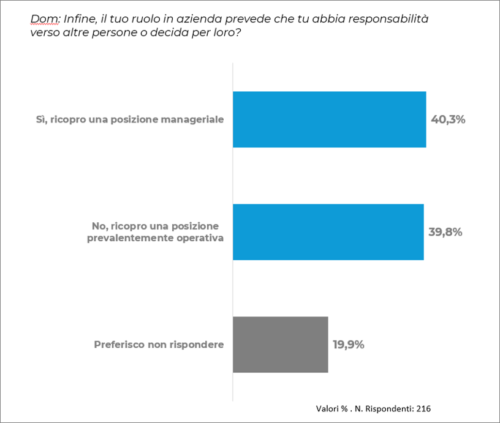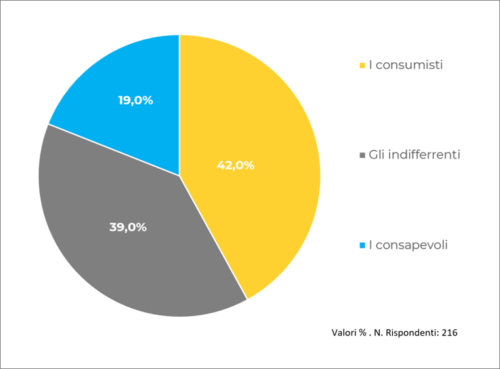At the Web Marketing Festival 2022, we wanted to do more than just talk about NeosVoc. We wanted to show how it works, taking the opportunity to better understand a very special audience. The research “Aware or Consumerist?” was born from the desire to discover how marketing and communication professionals perceive the most important topic of the moment: sustainability. We aimed to understand if the people most responsible for conveying attention to the environment are also, deep down, its true advocates. We will tell you all about it in this series of articles.
A few words on how we collected the data we will analyze here.

To contribute to the three days of the WMF 2022 with a valuable proposal, we decided to actively involve attendees by having them participate in an Instant Test, accessible through a QR Code we distributed at the event.
Our reference was the Green Potential Detection Model, NeosVoc’s analysis model on sustainability topics.
Those who responded to the short sequence of questions received immediate feedback, summarizing their individual results, and a more detailed feedback via email. During our demo in the hall, we presented the overall data, collected in real time.
Here, with a bit more analysis, is what we learned about this particular group’s inclination towards environmental awareness.
The Green Potential Detection Model
The Green Potential Detection Model (GPDM) was developed by a team of researchers and environmental sustainability experts, capable of identifying personality traits that predict our natural inclination towards adopting sustainable behaviors.
By starting with the detection of dispositional dimensions, the model identifies the potential within each individual regarding environmental sustainability issues. The addition of data on lifestyle and behaviors allows for a complete analysis, estimating the level of regional sensitivity and proximity to topics such as energy savings and a propensity to reduce consumption.
Among the objectives of the model is, of course, the identification of the most effective communication methods to promote “good practices,” increase awareness of environmental issues, and accelerate the adoption of eco-friendly habits. All of this is personalized based on the characteristics of each individual.
In addition to revealing the Green potential within each person, studying personality traits allows for personalized communication, identifying the most effective message for each user that aligns with their fundamental psychographic traits.
The sample
We decided to start our research journey on sustainability with a specific sample: those who work in communication and digital fields and thus play a key role in dissemination, communication, and awareness activities, including environmental issues. These individuals, in our view, can play a pivotal role in the challenge towards sustainability.
The data we will see here, therefore, cannot be considered representative of the Italian population but provide a snapshot of a selected sample, based on activity, training, and exposure to the topics discussed.
In particular, the analyses were conducted on a sample of 216 respondents, all adults, professionals from across Italy in the communication and digital marketing sectors who attended the Web Marketing Festival last June. Of these, 26.9% work in Marketing, 14.9% in Media, Communication, and Advertising, 10.0% in the creative field, and 8.5% are Technicians; the remaining respondents come from other professions. The sample is evenly split between managerial and operational roles.
An initial segmentation of the sample, due to the context in which we found ourselves, mainly includes professions related to marketing and communication, leaving little room for other professions.

From a gender perspective, alongside the 5% who prefer not to answer the question, the sample consists of 56.7% women and 38.3% men, primarily concentrated in the North (North-West 34.8% and North-East 23.9%) and the Center (26.4%), with lower representation from the South and Islands (12.9%). This concentration in the Center-North area is likely due to the event’s location, Rimini.



Regarding age, the sample is relatively young, distributed as follows among the various age groups: 18-24 years 13.4%; 25-34 years 35.8%; 35-44 years 27.9%; Over 45 21.9%.
A very special and extremely interesting sample. These are the people who, in their daily work, have the specific function of disseminating (information, communication, and consequently also culture on specific topics). Often trendsetters, they are the ones from whom citizens draw to create their own agendas.
The Environmental Awareness Index
The measure of environmental awareness, the Environmental Awareness Index (Indice di Consapevolezza Ambientale, ICA), is the result of a weighted average of a series of indicators. It is an index based on psychographic traits, not behaviors, and consequently measures only potential: which may or may not be realized.
By psychographic traits, we mean all the subjective characteristics that determine individuals’ behaviors and influence their choices. These characteristics include personality, lifestyle, values, tendencies, and interests, which help explain attitudes, behaviors, and habits. We will delve deeper into the topic of psychographic traits in the next chapter.
The 216 people who responded to our survey achieved an ICA of 5.8 out of 10: a generally positive value, as we will see later, with considerable room for improvement, of course.
The clusters
As we mentioned at the beginning, the GPDM considers two factors in its analysis: psychographic traits and behaviors.
The ICA is calculated based on psychographic traits: it tells us the propensity from which a person starts – which may or may not transform into action. However, if we stopped at this data, we would obtain partial information, as we would never understand if and how those predisposed to certain behaviors actually practice them. It’s akin to knowing someone has a good ear for music but ignoring whether they actually became a musician.
Therefore, the next step was to analyze the responses related to behaviors. From this analysis, which we will examine more closely in the next chapter, three clusters emerged: three groups of individuals who share similar characteristics, more or less explicitly: the Consumerists, the Indifferent, and the Aware.
And here they are.
The Consumerists

The Indifferents

With an Environmental Awareness Index (ICA) just slightly higher than that of the Consumerists (5.7), we find this group of people (39% of the sample) whose main characteristic is simply not feeling engaged with issues related to environmental sustainability.
Their behaviors related to lifestyle and energy and water conservation reflect this predisposition (or lack thereof): not virtuous enough to be classified as Aware, nor openly consumeristic, excluding, again, a tendency towards compulsive accumulation.
The Indifferents likely represent a population segment where successful intervention is possible, as both their psychographic traits and behaviors do not indicate rigidity.
The Aware

Comprising 19% of the sample, the Aware are the smallest cluster in numbers but also hold the most promise.
They typically work in Creative, Communication, or Project Management roles, often in managerial positions.
In terms of dispositional traits, they are characterized by strong conscientiousness, along with openness and friendliness. Despite showing a strong tendency towards self-assertion, they also have a strong need for belonging: suggesting that fulfillment can only be achieved when supported, accompanied, and recognized by a group.
Regarding behaviors, they are attentive to both energy and water conservation, and sustainability is generally a way of life for them. In other words, they can thrive socially without compromising their individuality, all while remaining mindful of the planet.
Undoubtedly, they are individuals who, empowered by their professional roles, can be true leaders and influencers.

In a world where “sustainability” has become a keyword, understanding the orientations of those who create and disseminate these keywords is crucial. The purpose of our research is precisely to identify points of intervention, trait by trait and behavior by behavior, laying the groundwork for effective yet personalized communication that is not mass-oriented. This research serves as an active lever for personalized communication aimed at raising awareness and promoting correct behaviors.
From what we have seen, there are numerous variables at play: this is the challenge of sustainability.
In the next chapter, we will delve deeper into how environmental sensitivity relates to our personalities, exploring how dispositional traits translate into behaviors.




